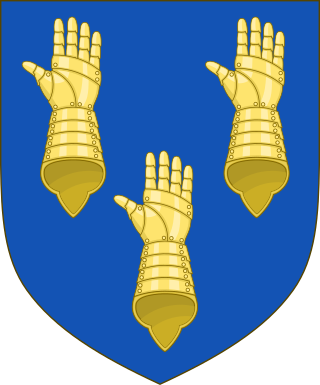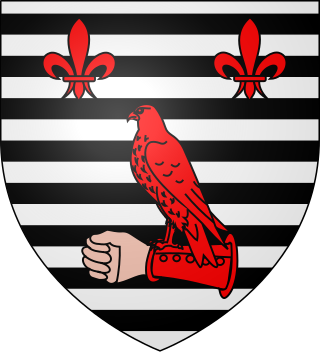
Viscount Hailsham, of Hailsham in the County of Sussex, is a title in the Peerage of the United Kingdom. It was created in 1929 for the lawyer and Conservative politician Douglas Hogg, 1st Baron Hailsham, who twice served as Lord High Chancellor of the Great Britain. He had already been created Baron Hailsham, of Hailsham in the County of Sussex, in 1928, also in the Peerage of the United Kingdom. Hogg was the son of the merchant and philanthropist Quintin Hogg, seventh son of Sir James Hogg, 1st Baronet, whose eldest son James McGarel-Hogg, 2nd Baronet was created Baron Magheramorne in the Peerage of the United Kingdom in 1887.

Baron Inglewood, of Hutton in the Forest in the County of Cumberland, is a title in the Peerage of the United Kingdom.

Earl of Malmesbury is a title in the Peerage of Great Britain. It was created in 1800 for the diplomat James Harris, 1st Baron Malmesbury. The son of the grammarian and politician James Harris, he served as Ambassador to Spain, Prussia, Russia and France and also represented Christchurch in the House of Commons. Harris had been created Baron Malmesbury, of Malmesbury in the County of Wiltshire, in 1788. He was made Viscount FitzHarris, of Hurn Court in the County of Southampton, at the same time as he was given the earldom. The earldom and viscountcy were the last creations in the peerage of Great Britain, future titles being made in the peerage of the United Kingdom which took effect three days later.
Earl of Swinton is a title in the Peerage of the United Kingdom. It was created in 1955 for the prominent Conservative politician Philip Cunliffe-Lister, 1st Viscount Swinton. He had already been created Viscount Swinton, of Masham in the County of York, in 1935, and was made Baron Masham, of Ellington in the County of York, at the same time he was given the earldom. Born Philip Lloyd-Greame, he was the husband of Mary Constance "Molly" Boynton, granddaughter of Samuel Cunliffe-Lister, 1st Baron Masham. When his wife inherited the large Masham estates in 1924, they assumed the surname of Cunliffe-Lister in lieu of Lloyd-Greame.

Earl of Listowel is a title in the Peerage of Ireland. It was created in 1822 for William Hare, 1st Viscount Ennismore and Listowel, who had earlier represented Cork City and Athy in the Irish House of Commons.

Earl of Portarlington is a title in the Peerage of Ireland. It was created in 1785 for John Dawson, 2nd Viscount Carlow, who had earlier represented Portarlington in the Irish House of Commons. He was the son of William Dawson, 1st Viscount Carlow, who had represented Portarlington and Queen's County in the Irish House of Commons, and had been created Baron Dawson, of Dawson's Court in the Queen's County, in 1770, and Viscount Carlow, in the County of Carlow, in 1776. These titles were also in the Peerage of Ireland. The first Earl was succeeded by his eldest son, the second Earl. He was a Colonel in the 23rd Light Dragoons but disappeared the night before the Battle of Waterloo and thus missed the start of the battle. He then attached himself to the 18th Hussars, but after the battle was forced to resign his commission in disgrace, fell into dissipation and 'died in an obscure London slum'.

Earl Howe is a title that has been created twice in British history, for members of the Howe and Curzon-Howe family respectively. The first creation, in the Peerage of Great Britain, was in 1788 for Richard Howe, 4th Viscount Howe, but it became extinct upon his death in 1799. The second creation, in the Peerage of the United Kingdom, was in 1821 for Richard Curzon-Howe, 2nd Viscount Curzon, and it remains extant.
Viscount Younger of Leckie, of Alloa in the County of Clackmannan, is a title in the Peerage of the United Kingdom. It was created on 20 February 1923 for the Unionist politician Sir George Younger, 1st Baronet. He had already been created a Baronet, of Leckie in the County of Clackmannan, in the Baronetage of the United Kingdom, on 12 July 1911. His grandson, the third Viscount, served as Lord Lieutenant of Stirlingshire from 1964 to 1979, whilst the third Viscount's brother was Labour MP Kenneth Younger. His son, the fourth Viscount, was a prominent Conservative politician. In 1992, five years before he succeeded his father, he was created a life peer as Baron Younger of Prestwick, of Ayr in the District of Kyle and Carrick. As of 2017, the titles are held by his son, the fifth Viscount, who succeeded in 2003 and joined the House of Lords as an elected hereditary peer in 2010.

Viscount Trenchard, of Wolfeton in the County of Dorset, is a title in the Peerage of the United Kingdom. It was created in 1936 for Marshal of the Royal Air Force, Hugh Trenchard, 1st Baron Trenchard. He had already been created a Baronet, of Wolfeton in the County of Dorset, in the Baronetage of the United Kingdom in 1919 and Baron Trenchard, of Wolfeton in the County of Dorset, in 1930, also in the Peerage of the United Kingdom. His second son, the second Viscount, held junior ministerial positions from 1979 to 1983 in the Conservative administration of Margaret Thatcher. As of 2018 the titles are held by the latter's son, the third Viscount, who succeeded in 1987. In 2004 he replaced the recently deceased Lord Vivian as one of the ninety elected hereditary peers that are allowed to remain in the House of Lords after the passing of the House of Lords Act 1999. Lord Trenchard sits on the Conservative benches.

Viscount Astor, of Hever Castle in the County of Kent, is a title in the Peerage of the United Kingdom. It was created in 1917 for the financier and statesman William Waldorf Astor, 1st Baron Astor. He had already been created Baron Astor, of Hever Castle in the County of Kent, in 1916, also in the Peerage of the United Kingdom.

Viscount Bledisloe, of Lydney in the County of Gloucestershire, is a title in the Peerage of the United Kingdom. It was created in 1935 for the Conservative politician Charles Bathurst, 1st Baron Bledisloe, upon his retirement as Governor-General of New Zealand. He had already been created Baron Bledisloe, of Lydney in the County of Gloucestershire, in 1918, also in the Peerage of the United Kingdom. Bathurst was the great-grandson and namesake of the early-19th-century politician Charles Bathurst. The latter was the son of Charles Bragge and Anne Bathurst, granddaughter of Sir Benjamin Bathurst, younger brother of Allen Bathurst, 1st Earl Bathurst. In 1804, Charles Bathurst assumed the surname of Bathurst in lieu of Bragge. The first Viscount's grandson, third Viscount, was one of the ninety elected hereditary peers that were allowed to remain in the House of Lords after the passing of the House of Lords Act 1999, and sat as a crossbencher until his death. He was also a member of the Lords Constitution Committee. As of 2017 the titles are held by his son, the fourth Viscount, who succeeded in 2009.

Baron Geddes, of Rolvenden in the County of Kent, is a title in the Peerage of the United Kingdom. It was created on 28 January 1942 for the prominent Conservative politician and former Ambassador to the United States, Sir Auckland Geddes. As of 2017 the title is held by his grandson, the third Baron, who succeeded his father in 1975. He is one of the ninety elected hereditary peers that remain in the House of Lords after the passing of the House of Lords Act 1999, and sits on the Conservative benches.

Baron Astor of Hever, of Hever Castle in the County of Kent, is a title in the Peerage of the United Kingdom. It was created in 1956 for John Jacob Astor, a prominent newspaper proprietor and Conservative politician. He was the fourth child of William Waldorf Astor, 1st Viscount Astor. Lord Astor of Hever was succeeded in 1971 by his eldest son, the second Baron, who served as Lord Lieutenant of Kent between 1972 and 1982.
Baron Trefgarne, of Cleddau in the County of Pembroke, is a title in the Peerage of the United Kingdom. It was created in 1947 for the barrister, journalist and politician, George Garro-Jones. In 1954 he assumed by deed poll the surname of Trefgarne in lieu of Garro-Jones. As of 2016 the title is held by his son, the second Baron, who succeeded in 1960. He served in junior ministerial positions in the Conservative administrations of Margaret Thatcher and is now one of the ninety elected hereditary peers that remain in the House of Lords after the passing of the House of Lords Act 1999.
Baron Crathorne, of Crathorne in the North Riding of the County of York, is a title in the Peerage of the United Kingdom. It was created in 1959 for the Conservative politician and former Minister of Agriculture and Fisheries, Sir Thomas Dugdale, 1st Baronet. He had already been created a baronet, of Crathorne in the North Riding of the County of York, in 1945. As of 2016 the titles are held by his son, the second Baron, who succeeded in 1977. Lord Crathorne is one of the ninety elected hereditary peers that remain in the House of Lords after the passing of the House of Lords Act 1999, and sits as a Conservative.
Baron Ravensdale, of Ravensdale in the County of Derby, is a title in the Peerage of the United Kingdom.

David McAdam Eccles, 1st Viscount Eccles, was an English Conservative politician.

John Dawson Eccles, 2nd Viscount Eccles,, is a British Conservative peer and businessman. He is one of the ninety-two hereditary peers elected to remain in the House of Lords after the passing of the House of Lords Act 1999.
Diana Catherine Eccles, Viscountess Eccles DL is a British Conservative peer and businesswoman.










